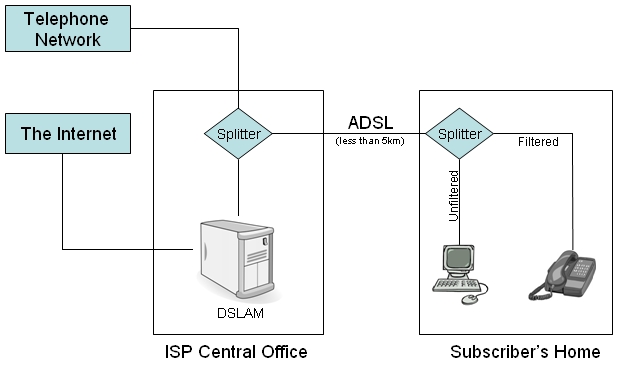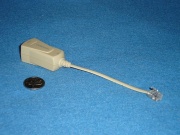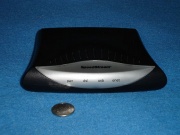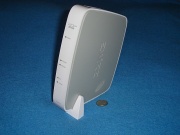Asymmetric Digital Subscriber Line
From Computing and Software Wiki
ADSL (Asymmetric Digital Subscriber Line) is one of the leading technologies for providing high-speed Internet service to subscribers. ADSL is a variant of DSL, and there exists a common misconception that the A stands for Asynchronous. This is incorrect, as ADSL is a synchronous service. It is, however, asymmetric because the available upstream bandwidth is much less than the downstream bandwidth. Though there are some limitations imposed on the technology such as maximum bandwidth, and maximum distance from the Central Office, ADSL continues to be a competitive force in the Internet service market.
ADSL provides much greater bandwidth than traditional voiceband modems, but does so while utilizing the same copper phone lines.
Contents |
Introduction to ADSL
History
Historically, Internet was served to people's homes through the use of voiceband data modems connect to the existing copper telephone line network. This network consists of twisted pair copper wires which run from a subscriber's home back to the telephone company's central office. The voiceband data modem made use of the same frequencies as human speech, up to about 3.4kHz, and as such was only able to achieve speeds of up to 56Kbps. This also had the disadvantage of tying up the phone line whenever the modem was in use. ADSL makes use of other frequencies which are not needed by traditional telephony services, allowing an ADSL signal to exist on a copper line in harmony with a voice signal.
Traditionally, when ADSL was run to a home, a whole home splitter was installed at the demarcation point, the point where the phone line enters the home from the street. The splitter would filter all existing phone lines in the home, and provide an unfiltered line for use by the ADSL modem. This approached proved to be rather expensive for the ISP as they would have to cover the cost of the splitter, as well as the technician who would go out and install the device. Most ISPs have now adopted a much more passive stance wherein they ship the subscriber a number of microfilters which users will have to place on each of their telephones. While cheaper for this ISP, this can lead to degradation of service for the consumer if they have more than 5 voiceband devices in their home. The reason for this is that the branching of the various phone lines causes reflections which interfere with the ADSL signal. A whole home splitter solves this problem in that there are no reflections; the ADSL modem is connected directly to the splitter, and is alone on an unfiltered line.
The Technology
ADSL differs from standard DSL in that the data flow is asymmetric; data flow is greater in one direction. This is due to the observation that most people use the Internet in a fairly passive fashion. Requests are placed to Internet servers for websites or files, which are then downloaded to the subscriber's PC. Requests are much smaller than the files and websites they lead to, so there is little need for large upstream transmission capability. As the Internet grows, so too does the size of the files people are downloading, and the size of the websites they are visiting. It makes sense that users should have a greater ability to download and view these files. In fact, even though the upload pipeline is very small, only recently has its bandwidth been fully used. The advent of technologies such as BitTorrent, which focuses on equal uploading and downloading, has finally begun to use the full upload bandwidth.
Functionality

|
Physical Setup
The physical setup of the ADSL system is fairly symmetrical. The core of the setup is the DSLAM (Digital Subscriber Link Access Multiplexer), a device which is responsible for intermixing the voice and data signals on the downstream side of the connection, and for separating out the voice from the data signal on the upstream side. On the upstream side, once the voice signal has been removed from the line, it is passed on to the phone company's telephony network. The data signal is passed onto the ISP's Internet backbone. On the downstream side, the DSLAM combines the voice and data signals coming from the phone network and the Internet, and transmits them down the twister pair copper line to the subscriber's home. There is a physical distance restriction imposed here, of about 5km. This is the maximum distance that a signal from a DSLAM can travel without degradation. Beyond this point, Internet service may be intermittent, or slow, or just not possible. For this reason, ISPs will not provide ADSL to people living outside of the 5km service area of a DSLAM. After the signal arrives at the subscriber's home, one of two situations is possible. Either a whole home splitter is installed, which filters the ADSL signal from the home's phone lines, and passes it along an unfiltered line to an ADSL modem, or the subscriber has installed microfilters on their voiceband devices, filtering out the ADSL at the wall jacks. Either way, the signal must now pass into an ADSL high speed modem, which will interpret the signal, and communicate with either a computer, or a router, providing Internet access. ADSL modems are power hungry devices and require their own power source; there is no way to incorporate them into a home computer system the way that voiceband modems have been.
Transmission
Traditional voice telephony only utilizes a very small portion of the possible bandwidth in a copper wire. In fact, all voiceband communications fall within the range between 0 and 4kHz. ADSL makes use of the higher frequencies supported by the copper wire. The frequencies within the copper line are broken down as follows:
- 0kHz - 4kHz: Voiceband Services
- 4kHz - 28.875kHz: Unused buffer area
- 28.875kHz - 138kHz: Used for upstream transmission,
- 138kHz - 1104kHz: Used for downstream transmission.
Note that the upstream frequency range is much smaller than the downstream frequency range. This is the asymmetric nature of ADSL; in true DSL, the upstream and downstream frequency spreads are equal. Also note that ADSL is a full duplex technology, which means that signals can be travelling in opposite directions at the same time, on a single wire. An easy way to conceptualize the use of the frequency ranges is to imagine the ranges as "pipes" through which the various signals travel like water. The larger the pipe, the more water can travel through it.
The two main frequency ranges are further subdivided into smaller units, called channels, each of which span approximately 4kHz. When an ADSL link is first established the modem on the user end and the DSLAM on the provider end test the channels on the line to establish which ones have the best signal-to-noise ration, a measure of how much interference exists in that channel versus how strong the ADSL signal is. Interference on a channel can come from poor wire quality, noise on the line, or even AM radio signals (a copper phone line can be thought of as a large antennae). Once the best channels are determined, these channels are used for communication. If the signal ever becomes degraded to the point that communication is no longer possible, the channels are re-evaluated. It should be noted, however, that the amount of available bandwidth decreases with each unusable channel.
The Future of ADSL
The Growth of ADSL
In recent years ADSL has enjoyed a huge surge in popularity. As the Internet grows and the demand for streaming video and other such high bandwidth applications increases, voiceband technology has been all but abandoned in favour of Highspeed Internet. Due to the ease of installation, and the fact that it utilizes technology already present in every home with a telephone, ADSL has become extremely popular.
In the coming years, ADSL service providers will continue to expand their coverage. As things stand at the moment, ADSL is only available in densely populated areas, and even then there are gaps in the service. This stems from the fact that the ADSL signal degrades rapidly and becomes unstable at distances great than 5km. Service providers are solving this problem by running fibber optic lines from the central office to remote DSLAMs in locations where service was previously unavailable. The practice can also increase the speeds available to people who already fall within an ADSL service area by connecting them to a DSLAM which is closer to their home (for instance if they were previously being served from a DSLAM 4.5km away, and a new one is installed less than 1km distant).
New Devices
Up until recently, when someone subscribed for ADSL service, they would receive an ADSL modem from the ISP. This modem would then be attached to the phone line and the subscriber's computer, providing Internet service. If the subscriber wished to use more than one computer with the service, he would be forced to purchase a router. Lately, ISPs have begun to distribute devices where are being termed "Home Gateways". These devices incorporate the ADSL modem, a 4 port home router, and a wireless access point into one compact form factor. With home networking on the rise, these devices are expected to be extremely popular with home users as they will limit the clutter required for a home network, and centralize control of all aspects of the network into one device.
Competition
Despite its recently surge, however, when one looks to the future of ADSL over the next ten years, the outlook does not look good. New technologies are emerging that could eclipse and even replace ADSL altogether. Some ISPs have already begun to roll out the successor to ADSL, ADSL2, which features greater bandwidth and speeds through the use of greater frequency ranges. However, even the new ADSL2 is eclipsed by the emerging VDSL (also known as VHDSL). VDSL, Very High Speed Digital Subscriber Line, provides speeds up to 100Mbits/s in both directions through the utilization of frequencies up to 30MHz. Though it is still an emerging technology in the Western world, VDSL has seen widespread adoption in Japan and South Korea where it is the predominant high speed Internet technology.
See Also
Wireless Network Security
WiMAX
Mesh Networking
Designing a Small Business Intranet
Internet Cookies and Confidentiality
References
- ADSL. (2008). Wikipedia Retrieved April 6, 2008 from http://en.wikipedia.org/wiki/Adsl
- Tyson, Jeff. How VDSL Works. How Stuff Works.com. Retrieved April 7, 2008 from http://electronics.howstuffworks.com/vdsl1.htm
- Volf, Zahy. Anita Demayo. Roei Limoni. ADSL. RAD University. Retrieved April 7, 2008 from http://www2.rad.com/networks/2005/adsl/main.htm
- Hamill, Hugh et all. Asymmetric Digital Subscriber Line. Retrieved April 7, 2008 from http://www.esatclear.ie/~aodhoh/adsl/report.html
- VDSL. (2008). Wikipedia Retrieved April 6, 2008 from http://en.wikipedia.org/wiki/VDSL
External Links
--Durandal 22:15, 13 April 2008 (EDT)



